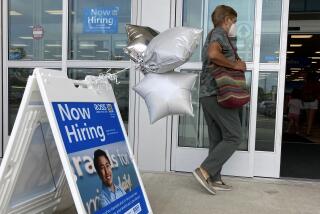Job growth boosts fears of inflation
WASHINGTON — The government’s surprisingly bullish report Friday showing strong employment and wage growth, while good news for workers, revived concerns about inflation and dashed hopes of a quick Federal Reserve interest-rate cut.
The Labor Department said employers added a net 167,000 jobs to their payrolls in December, the most since September and substantially more than the 110,000 expected in the consensus forecast of private economists. The job growth was enough to hold the unemployment rate steady at a low 4.5%.
Also, wages rose faster than inflation, continuing a departure from earlier in the current four-year-old cycle of employment growth. Average hourly earnings of production workers jumped to $17.04, an increase of 8 cents, or 0.5%, from the previous month.
For all of 2006, average weekly wages climbed 4.5%, more than enough to keep pace with price increases of about 2% during that period. The last 12-month period when weekly wages rose that much ended in February 1998.
But stocks fell and bond yields rose as investors figured that the Fed, on guard against inflation, would not risk an interest-rate cut that could stimulate economic activity and feed inflation.
Investors had been hoping for a rate cut possibly as early as March. The central bank’s next rate-setting meeting is Jan. 30-31.
The report also illustrated the split economy, with strong job growth in services but slumping hiring in manufacturing.
Nigel Gault, U.S. economist for research firm Global Insight, called the report “rock solid,” but acknowledged its negative implications for interest rates: “A first-quarter rate cut is now out of the question, and the odds of a second-quarter cut are receding.”
Sounding an even more bearish note, Mark Zandi, chief economist for Moody’s Economy.com, said jobs and wages were growing too fast for their own good. He warned that higher wages could induce companies to raise prices, which could lead workers to demand higher wages -- an inflationary wage-price spiral.
Zandi predicted that job growth would slow, especially if cold weather settled in over the Northeast, depressing the construction industry.
“But if it doesn’t,” he said, “the Federal Reserve will be raising interest rates again by spring. The economy is already operating above full employment, and very strong growth today could paradoxically lead to slower growth a year from now.”
For all of 2006, the Labor Department report showed, the economy generated nearly 2 million jobs, an unexceptional pace for this stage of an economic expansion. But the unemployment rate, 4.9% at the end of 2005, fell by 0.4 percentage points to a level that Zandi said was lower than the economy could sustain over the long run.
Job creation for November and October was revised upward by a combined 29,000 jobs, resulting in net gains of 154,000 positions in November and 86,000 in October.
Sectors adding jobs last month included architectural and engineering outfits, hospitals and doctors’ offices, banks, computer design firms, bars and restaurants, hotels and motels, and schools. But construction, hit by the housing slowdown, lost jobs, as did retailing.
The manufacturing sector also did not share in December’s employment gains. It lost 12,000 jobs, bringing its total 2006 decline to 72,000 positions, while the service sector added nearly 180,000 jobs last month and 1.8 million for the year.
Peter Schiff, president of investment advisory service Euro Pacific Capital, found those numbers to be ominous.
“We’re destroying the jobs of people who make things and creating more people who want to consume things,” he said. Consumers, he said, have no choice than to look overseas for what they want.
“What America needs is more people making stuff and fewer people providing services,” he said. “The only way to have a vibrant service sector is to have strong manufacturing. It’s hard to sell services overseas: There’s no one in China who wants our legal advice, and nobody in Japan is going to fly over here to get a haircut.”
*
More to Read
Inside the business of entertainment
The Wide Shot brings you news, analysis and insights on everything from streaming wars to production — and what it all means for the future.
You may occasionally receive promotional content from the Los Angeles Times.









